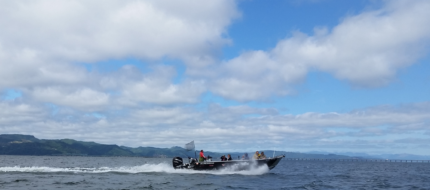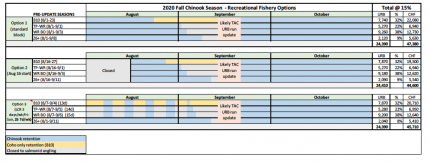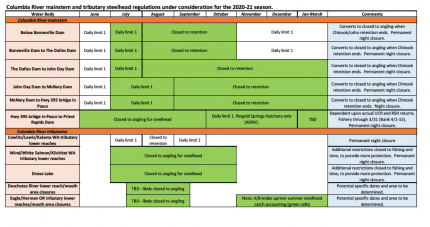Buoy 10, Lower Columbia, Gorge Pools Fall Chinook Fishing Options Out For Comment
Three fall Chinook fishing options for the Lower Columbia were trotted out today by ODFW and WDFW for public comment, along with other salmon and steelhead proposals for the mainstem and its tributaries from Buoy 10 to Tri-Cities.
The trio of king alternatives include a standard season starting Aug. 1 and running well into the month, a midmonth opener, and a three-day-a-week approach, all with a one-fish daily bag limit and a salmonid angling closure on the mainstem when Chinook retention is shut down.

The pros and cons were debated by guides, industry reps and anglers during a webinar instead of the usual inperson meeting due to the COVID-19 outbreak. With the final stage of the annual North of Falcon salmon season setting process beginning this Friday, managers were looking for a fast turnaround on the options.
While they’re forecasting 431,000 Columbia fall Chinook out in the ocean, they’re also wary of the 233,300 upriver bright forecast being so close to 200,000, so before the mid-September runsize update will be managing inriver fisheries for an 8.25 percent recreational harvest rate. The three options would yield overall catches of 24,390 to 24,410 upriver brights and 44,600 to 47,380 fall kings overall.
Option 1 would provide 23 days of Chinook retention at Buoy 10 (Aug. 1-23), 32 days from Tongue Point to Warrior Rock (Aug. 1-Sept. 1), 34 from Warrior Rock to Bonneville Dam (Aug. 1-Sept. 3), and 39 days (Aug. 1-Sept. 8) from Bonneville to Highway 395 in Tri-Cities.
Coho would open Aug. 1 too.
Just in terms of the numbers of days of time on the water, it provides the most time on the water. While it was listed as a con, it would also allow anglers to move upstream with the fish as lower sections close.
Option 2 features an Aug. 16 start for all areas — including for coho — with 12 days of fishing at Buoy 10 (through Aug. 27), 17 above Tongue, 19 above Warrior, and 27 above Bonneville.
Opening the fishery later yields more prime days during the heart of the upriver bright run and protects select area fall brights and lower river hatchery king. However, it also means fewer days on the water, closes Buoy 10 to coho fishing for the first half of the month, and there’s a higher risk to starting king season later at the mouth of the Columbia, managers state.
As for Option 3, Chinook fishing would begin Aug. 7 in all three zones below Bonneville but only be open for Chinook retention Friday through Sunday (coho would be open daily starting Aug. 1), yielding 13 days at Buoy 10, 14 above Tongue and 15 above Warrior. Fishing from Bonneville to 395 would be open for 42 days between Aug. 1 and Sept. 11.
Pros include pushing Chinook retention into September and the important Labor Day Weekend, but it also cuts into upriver time on the water.

During public comment, there was little if any support for the middle option, with most on the webinar preferring 1 or 3.
The latter’s weekend approach for Chinook fishing represented something of a series of openers to build excitement around and stretch the season later, in the opinion of longtime gear rep Randy Woolsey.
Greg King, president of the new Puget Sound Anglers Lower Columbia River Chapter, liked the first option, saying it represented “the best bang for the buck.”
“Economically, everybody needs a shot in the arm up and down the river,” he said.
Referencing the “grim times” of the COVID-19 outbreak, Liz Hamilton of the Northwest Sportfishing Industry Association also expressed interest in generating maximum economic activity and called for unity and providing something for anglers to look forward to.
To comment on fisheries below Bonneville go here; to comment on fisheries from the dam to Highway 395, go here.
Also of note, it appears that WDFW is proposing to open parts of the Grays and Elochoman for hatchery coho retention following a switch in production of the stock from the former river to the latter. The agency’s tributary proposals are here.
WDFW and ODFW staffers also outlined mainstem and tributary summer steelhead closures being considered.
The nut is that recent years’ tributary restrictions could be tightened even more, with Drano Lake and the lower reaches of the Wind, White Salmon and Klickitat to be closed from July through October, and Oregon’s Deschutes Rivers and Eagle and Herman Creeks are likely to see large summer closures too.

The mainstem Columbia’s “rolling block” closures would also return as an “exceptionally low” run of just 99,000 A- and B-runs return to inland rivers, worrying managers about being able to meet hatchery broodstock goals for both stocks as well as wild A-run escapement.
Correction: 9:50 a.m., April 2, 2020: Greg King’s affiliation in the original blog was misstated as Friends of the Cowlitz, an organization he was formerly strongly associated with and still supports. He is now serving as president of the new Puget Sound Anglers Lower Columbia River Chapter.





